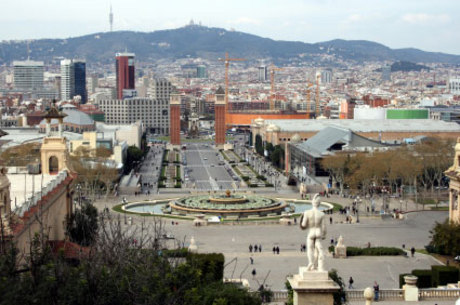Plaça d'Espanya
The Plaça d'Espanya is a square located at the foot of the Montjuïc. The site was used for public hangings until the gallows were moved to the Ciutadella in 1715.
The Plaça d'Espanya was created for the 1929 World Exhibition. Designed in 1915 by the architect Josep Amargós, it was only completed just in time for the exhibition. One of the city's biggest squares, it is the junction of several major thoroughfares: Gran Via de les Corts Catalanes, Avinguda del Parallel, Carrer de la Creu Coberta and Carrer de Tarragona, and leads to the Palau Nacional through Avinguda de la Reina Maria Cristina, which houses one of Catalonia's finest museums, the Museu Nacional d'Art de Catalunya (MNAC). It was designed by Josep Amargós. The fountain at the centre of the square was designed by Josep Maria Jujol, a collaborator of Antoni Gaudí, while Miquel Blay designed the statues. The buildings were designed by Nicolau Maria Rubió i Tudurí.
The square was built on a site that had been previously used for public hangings, until the creation of the now demolished Ciutadella fortress in 1715, where the gallows were moved. It was designed in 1915 and built in 1929 so that it could be ready to host the 1929 Universal Exposition. In 1928, the dictator Miguel Primo de Rivera, who led the Spanish government at the time, ordered the pulling down of the four Ionic columns known as Les quatre columnes, built ten years before by Puig i Cadafalch, that symbolised the four bars of the Catalan flag as part of his banning of all Catalan symbols. The square has been in public use since then.
Another architect, Josep Maria Jujol designed a large fountain at the center of the square. His modernist style is clearly influenced by Gaudi, with whom Jujol frequently collaborated on projects like the Casa Milà and Parc Guëll. The sculptures adorning the fountain were created by the Spanish sculptor Miguel Blay Fabregas.
A wide avenue, the Avinguda de la Reina María Christina, is flanked by two towers and leads to the Magic fountain and the Palau National at the Montjuïc. The avenue is often used for trade fairs.
The 47m / 154ft high towers are modeled on the Bell Tower of the St. Mark's Basilica in Venice. They were built by Ramon Raventós for the 1929 International Exhibition.
At the other end of the Plaça d'Espanya stands the 'Arenas de Barcelona'. The bullring in Mudéjar style brickwork was built in 1900. But bullfights have never really caught on in Catalonia and the arena is now being turned into a shopping center.
Placa Espanya is a lovely plaza just out of the centre of town, where many of the main roads in Barcelona, such as Gran Via and Parallel intersect. It is also home to Barcelona’s old bull-fighting ring which is now nothing but a shell, albeit quite a beautiful one. That’s why lots of city tours pass through the square.
The main draw to Placa Espanya is the Palau Nacional which is the Museum of Catalan art, stands regally up on the side of Montjuic. It’s stunning and there is never a better time to see it than when it is lit up at night with the Magic Fountain in front. Near Montjuic Hill you can find all kinds of hotels and apartments for rent, where you can stay during your vacation in Barcelona. You can get there via direct flight to Barcelona or to Girona, Reus or Lleida –Alguaire.




